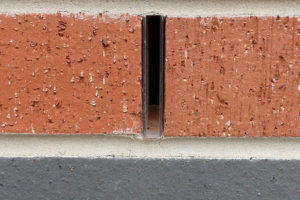Outlining the Regulations
- The Building (Scotland) Regulations – Domestic
- Cavities should be vented to the outside air by installing ventilators with at least 300mm² free opening area at 1.2m maximum centres.
- Precipitation can penetrate the outer leaf of an external wall and cavities are normally drained through weep holes.
- These weep holes can also provide the necessary venting.
- NHBC Standards
- The cavity should be ventilated and ventilation openings should be equivalent to open brick perpends every 1.2m (an open brick perpend 10mm wide x 65mm high equates to an air space of 650mm²).
Points to consider when choosing a weep vent:
- Some weep vents are primarily drainage units with venting as their secondary job – is this style going to give you the best performance?
- Some weep vents provide very little air flow (one as low as 90mm² per unit) so you may have to install more than you think.
- When comparing prices remember how many more you will be buying – and how frequently they will have to be installed.
- Important: The air space of a weep vent can vary greatly from manufacturer to manufacturer. To ensure you do not fall short of the ventilation requirements check the air space of the weep vent and check your spacings!
Rytons Slim Vent® Minor
- The original perpend cavity vent used by major house builders nationwide.
- With a huge air space, Rytons Slim Vent Minor cavity weep vents may be fitted at the maximum 1.2m centres in Scotland and approximately every third brick to NHBC Standards, giving a cost efficient advantage with no compromise on quality.
- Available in clear to suit any colour of mortar and brickwork.
All information given is in good faith and to the best of our knowledge is true and accurate at the date of publication. However, no guarantee regarding its accuracy is given, nor should Rytons representatives or agents imply any such guarantee. Customers should satisfy themselves that the products are suitable for the intended purpose.

